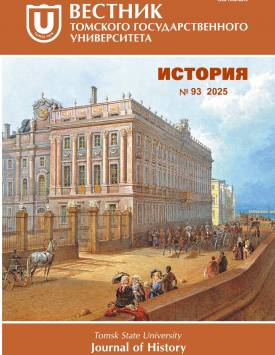Formation of the images of radicals in the revolutionary periodicals of Russian Empire in the second half of the 19th century and in the early 20th century
This article aims to determine the specifics of forming of the image of Russian revolutionary (radicals) in the illegal newspapers «Narodnaya Volya» and «Revolutionary Russia». The unique informational sources include many different materials - policy documents, letter of the revolutionary (Narodnik’s and Esers), testimony at the trial, publicity material about recent events all over the country. In the second half of the 19th century and in the early 20th century, the image of revolutionary was influenced by Christian tradition. The radical publicists appealed to stories from the Scriptures and early Christianity and draw parallels with modern realities. Russian terrorists have been compared to the tyrannies and radicals of recent and distant history. This was done in order to legitimate the terroristic activity. It was a definite character: the revolutionaries were involved in the "course of history" that would lead to revolution. The Socialist-Revolutionaries’ publicists compared terrorists with the image of legendary heroes from ancient and medieval mythology and modern poetry. They also appealed to images of «martyrs» (revolutionary of Narodnaya Volya). Therefore, the image was literary character and not real. The heroic image was to represent the peasantry and proletariat because the terrorists were from the lower classes. The audience connected their life with difficult situation of revolutionary and felt compassion for them. The populace became influential social support of Socialist-Revolutionary Party and Combat Organization. Publicists of «Narodnaya Volya» sought to create an ideal line of revolutionary life from birth to death. Autobiographies of the Socialist-Revolutionaries were to become very popular in «Revolutionary Russia». They marked the individuality of revolutionaries and their desire for a moral ideal. Terrorists accepted their death with confidence and were sure of the right path. The way of the terrorist was permanent «wandering» in which he eventually chooses between joining the Social Revolutionary Party or the Combat Organization. The use of personal sources was necessary for objectivity of the images of radicals and their ideas and thoughts. The image of ideal revolutionary was created for inspiring the like-minded people and supporters of the terror to follow «self-sacrifice» model. The image also had an impact on the collective memory of people, in which revolutionaries would remain in a positive tone. The author declares no conflicts of interests.
Keywords
information field, image of Russian revolutionary, revolutionary terror, periodical pressAuthors
| Name | Organization | |
| Strokolskiy Vladislav A. | Tomsk State University | kemerovo40@gmail.com |
References

Formation of the images of radicals in the revolutionary periodicals of Russian Empire in the second half of the 19th century and in the early 20th century | Tomsk State University Journal of History. 2025. № 93. DOI: 10.17223/19988613/93/12
